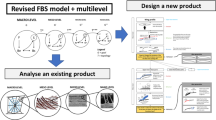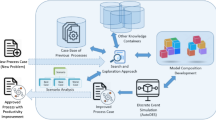Abstract
An approach to improve the management of complexity during the redesign of technical processes is proposed. The approach consists of two abstract steps. In the first step, model-based reasoning is used to generate automatically alternative representations of an existing process at several levels of abstraction. In the second step, process alternatives are generated through the application of case-based reasoning. The key point of our framework is the modeling approach, which is an extension of the Multimodeling and Multilevel Flow Modeling methodologies. These, together with a systematic design methodology, are used to represent a process hierarchically, thus improving the identification of analogous equipment/sections from different processes. The hierarchical representation results in sets of equipment/sections organized according to their functions and intentions. A case-based reasoning system then retrieves from a library of cases similar equipment/sections to the one selected by the user. The final output is a set of equipment/sections ordered according to their similarity. Human intervention is necessary to adapt the most promising case within the original process.
Similar content being viewed by others
References
Aamodt A, Plaza E (1994) Case-based reasoning: foundational issues, methodological variations and system approaches. AI Commun 7:39–59
Alberts LK, Bakker RR, Beekman D, Wognum PM (1993) Model-based redesign of technical systems. In: Proceedings of the 4th international workshop on principles of diagnosis, Aberytwith, Wales
Arana I, Ahriz H, Fothergill P (2001) Redesign knowledge analysis, representation and reuse. In: Industrial knowledge management a micro-level approach. Springer-Verlag, Berlin
Bakker RR, Eldonk SJ, Wognum PM, Mars NI (1994) The use of model based diagnosis in redesign. In: Proceedings of the workshop on reasoning about physical system, 11th ECAI, Amsterdam, The Netherlands, pp 647–651
Blessing L, Wallace K, Pahl G, Beitz W, Wallace K, Bauert F (1999) Engineering design: A systematic approach. Springer-Verlag, London
Branting LK, Aha DW (1995) Stratified case-based reasoning: reusing hierarchical problem solving episodes. In: Proceedings of the 14th international joint conference on artificial Intelligence, Montreal, Canada, pp 384–390
Chittaro L, Guida G, Tasso C, Toppano E (1993) Functional and teleological knowledge in the multimodeling approach for reasoning about physical systems: a case study in diagnosis. IEEE Trans Syst Man Cybern 23(6):1718–1751
Clarkson PJ, Simons CS, Eckert CM (2004) Predicting change propagation in complex design. SME J Mech Des 126(5):765–797
Douglas JM (1988)Conceptual design of chemical process. McGraw-Hill, New York
Eldonk SJ, Alberts LK, Bakker RR, Diker F, Wognum PM (1996) Redesign of technical systems. Knowl Based Syst 9(2):93–104
Fensel D, Motta E, Harmelen F, Benjamins R, Crubezy M, Decker S, Gaspari M, Groenboom R, Grosso W, Musen M, Plaza E, Schreiber G, Studer R, Wielinga B (2003) The unified problem-solving method development Language UPML. J Knowl Inf Syst 5(1):83–131
Forbus KD (1984) Qualitative process theory. Artif Intell 24(1–3):85–168
Friedman-Hill E (2004) Jess 7.0 manual. Sandia National Laboratories. Livermore, USA, http://herzberg.ca.sandia.gov/jess/docs/index.shtml
Ganesan P, Garcia-Molina H, Widom J (2003) Exploiting hierarchical domain structure to compute similarity. ACM Trans Inf Syst 21(1):64–93
Goel A (1997) Design, analogy and creativity. IEEE Expert Spec Iss Artif Intell Des 12(3):62–70
Hysys (2004) AEA technology engineering software hyprotech. Calgary, Canada
Jaffe MS, Leveson NG, Heimdahl MP, Melhart B (1991) Software requirements analysis for real-time process-control systems. IEEE Trans Softw Eng 17(3):241–257
Jurisica I, Mylopoulos J, Yu E (2004) Ontologies for knowledge management: Aninformation systems perspective. J Knowl Inf Syst 6(4):380–401
Kraslawski A, Koiranen T, Nystrom L (1995) Case-based reasoning system for mixing equipment selection. Comput Chem Eng 19:S821–S826
Kotsakis E (2002) XSD: A hierarchical access method for indexing XML schemata. J Knowl Inf Syst 4(2):168–201
Larsson JE (1996) Diagnosis based on explicit means-end models. Artif Intell 80(1):29–93
Lind M (1994) Modeling goals and functions on complex industrial plants. Appl Artif Intell 8:259–283
Lind M (1996) Status and challenges of intelligent plant control. Annu Rev Control 20:23–41
Lind M (1999) Plan modeling for human supervisory control. Trans Inst Meas Control 21(4/5):171–180
López-Arévalo I, Rodríguez-Martínez A, Bañares-Alcántara R, Aldea A (2003) Towards the automatic identification of process sections during the redesign of petroleum and chemical processes. In: Proceedings of the 2nd workshop on intelligent computing in the petroleum industry, 18th IJCAI, Acapulco, Mexico, pp 56–61
López-Arévalo I, Rodríguez-Martínez A, Aldea A, Bañares-Alcántara R, Jiménez L (2005) Redesign support framework based on hierarchical multiple models. In: Proceedings of the 2nd MONET workshop on model-based systems, 19th IJCAI, Edinburgh, Scotland
López-Arévalo I, Rodríguez-Martínez A, Bañares-Alcántara R, Jiménez L, Aldea A (2006) Generation of process alternatives using abstract models and case-based reasoning. Comput Chem Eng (in press), available online September, 25, 2006
Niles I, Pease A (2001) Origins of the standard upper merged ontology: A proposal for the IEEE standard upper ontology. In: Proceedings of the workshop on the IEEE standard upper ontology, 17th IJCAI, Seattle, WA
Ozone (2003) Ozone developers guide, http://www.ozone-db.org/frames/documentation/overview.html
Pajula E, Seuranen T, Koiranen T, Hurme M (2001) Synthesis of separation processes byusing case-based reasoning. Comput Chem Eng 25:775–782
Pos A (1997) Problem solving for redesign. In: Proceedings of the 10th European workshop on knowledge acquisition, modeling and management, Sant Feliu de Guixols, Spain, pp 205–220
Price CJ, Snooke NA, Lewis SD (2003) Adaptable modeling of electrical systems. In: Proceedings of the 17th international workshop on qualitative reasoning, Brasilia, Brazil, pp 147–153
Rasmussen J, Lind M (1981) Coping with complexity, Technical Report RISø-M-2293, Electronic Department, Riso National Laboratory, Denmark
Rasmussen J (1986)Information processing and human-machine interaction: An approach to cognitive engineering. Elsevier, Amsterdam
Rasmussen J (1990)Mental models and the control of actions in complex environments. In: Mental models and human–computer interaction. vol 1. North-Holland, Amsterdam
Rodríguez-Martínez A, López-Arévalo I, Bañares-Alcántara R, Aldea A (2003) Automatic hierarchical abstraction tool for the retrofit of processes. In: 4th European Congress in chemical engineering – computer aided modeling, simulation and optimisation, Granada, Spain, pp O-9.2-005
Rodríguez-Martínez A, López-Arévalo I, Bañares-Alcántara R, Aldea A (2004) Multi-model knowledge representation in the retrofit of processes. Comput Chem Eng 28:781–788
Smith B, Keane MT,Cunningham P (2001) Hierarchical case-based reasoning integrating case-based and decompositional problem solving techniques for plant-control software design. IEEE Trans Knowl Data Eng 13(5):793–812
Steinberg L, Mitchell T (1985) The redesign system: a knowledge-base approach to VLSI CAD. IEEE Des Test Comput 2:45–54
Takeda H (1994) Abduction for design. In: Proceedings of the formal design methods for CAD, Tallinn, Estonia, pp 221–243
Teck T (1995) Derivation and use of function in the design of chemical processes, MSc. Dissertation, University of Edinburgh, UK
Tombros A, Rijsbergen CJ (2004) Query-sensitive similarity measures for information retrieval. J Knowl Inf Syst 6(5):617–642
Turton R, Bailie RC, Whiting WB, Shaeiwitz JA (1998) Analysis, synthesis and design of chemical process. Prentice-Hall, Englewood Cliffs, NJ
Umeda Y, Tomiyama T (1997) Functional reasoning in design. IEEE Expert 12(2):42–48
Vicente KJ, Rasmussen J (1992) Ecological interface design: theoretical foundations. IEEE Trans Syst Man Cybern 22(4):589–606
Wetzel B (2000) The selection engine project, http://selectionengine.sourceforge.net
Author information
Authors and Affiliations
Corresponding author
Additional information
I. López-Arévalo received the B.Sc. degree in Computer Engineering from the Technical Institute of Tapachula, Mexico in 1998. He did a specialization in computer science at the Center for Computing Research of the National Polytechnic Institute (IPN), Mexico City, Mexico in 1999. In March 2006, he obtained the Ph.D. degree from the Technical University of Catalonia (UPC), Barcelona, Spain. He was the recipient of a doctoral studentship and is a member of the Research Group on Artificial Intelligence of the Department of Computing Engineering and Mathematics at the University Rovira i Virgili (URV), Tarragona, Spain. Currently, he is a researcher at the Laboratory of Information Technology of Cinvestav in Mexico. His research interests include model-based reasoning, case-base reasoning, and knowledge representation.
R. Bañares-Alcántara has worked in the University of Oxford since October 2003 and is now a Reader in Engineering Science in the Department of Engineering Science and a Fellow in Engineering in New College. He previously held a readership at the University of Edinburgh and lectureships at Tarragona (Spain) and the Universidad Nacional Autónoma de México (UNAM). He obtained his undergraduate degree from UNAM and the M.S. and Ph.D. degrees from Carnegie Mellon University (CMU). Starting with his postgraduate research work at CMU, his research interests have been in the area of process systems engineering, in particular in design and synthesis of chemical processes. He has developed a strong relationship with computer science/artificial intelligence research groups in different universities and research institutes, with current research also linking to social and biological modeling. He has (co)authored more than 100 refereed publications and has been a principal investigator and researcher in several projects funded by EPSRC and the European Union.
A. Aldea graduated in 1988 from the University of the Basque Country (Spain) with a B.Sc. (Hons.) in Physics. She then undertook research in Edinburgh for 9 years at Heriot-Watt University first as a Ph.D. student and later as a Postdoctoral Researcher. In 1999, she took a Lecturer position at the University Rovira i Virgili (Spain) where she began working with multiagent systems (MAS) and their application to social agents. In 2003, she moved to UK and started working as part-time Lecturer in the University of Reading. Finally she joined Oxford Brookes University full-time in September 2004 and is now a Senior Lecturer. In 1999, she helped create a multi-disciplinary research group, formed by computer scientists and engineers, which worked on the application of artificial intelligence techniques to industrial problems. She was involved in projects related to MBR, MAS, knowledge-management, ontology-based information retrieval, and simulation of human social behavior during team work.
A. Rodríguez-Martínez received the B.Sc. in chemical engineering in 1993 from Universidad Autónoma del Estado de Morelos (UAEM), Mexico. For the period March 1995 to January 2000 he was a researcher in the Department of Supervision and Automatization of Electrical Research Institute, Mexico. From 2000 to 2005, he was a Ph.D. student of Process Design and Synthesis Group, University Rovira i Virgili, Spain. The main topics of his Ph.D. dissertation include the retrofit of chemical processes based on hierarchical representation. Currently (June 2005 to date), he is an Associate Research-Professor in the Engineering and Science Research Centre (CIICAp) at UAEM. His research interests include artificial intelligent methodologies applied to design, synthesis, and retrofit of chemical processes.
Rights and permissions
About this article
Cite this article
López-Arévalo, I., Bañares-Alcántara, R., Aldea, A. et al. A hierarchical approach for the redesign of chemical processes. Knowl Inf Syst 12, 169–201 (2007). https://doi.org/10.1007/s10115-006-0060-4
Received:
Revised:
Accepted:
Published:
Issue Date:
DOI: https://doi.org/10.1007/s10115-006-0060-4




